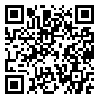Volume 2, Issue 1 (april 2018)
ohhp 2018, 2(1): 62-68 |
Back to browse issues page
Mahdi MALEK 
 , Mehrzad EBRAHEMZADEH
, Mehrzad EBRAHEMZADEH 
 , Hosein ARAB FARASHAHI *
, Hosein ARAB FARASHAHI * 
 , Mohammad Reza BESHARATI
, Mohammad Reza BESHARATI 
 , Morteza MORTAZAVI MEHRIZI
, Morteza MORTAZAVI MEHRIZI 
 , Mohammad Reza MOZAIAN
, Mohammad Reza MOZAIAN 


 , Mehrzad EBRAHEMZADEH
, Mehrzad EBRAHEMZADEH 
 , Hosein ARAB FARASHAHI *
, Hosein ARAB FARASHAHI * 
 , Mohammad Reza BESHARATI
, Mohammad Reza BESHARATI 
 , Morteza MORTAZAVI MEHRIZI
, Morteza MORTAZAVI MEHRIZI 
 , Mohammad Reza MOZAIAN
, Mohammad Reza MOZAIAN 

School of Medical, Shahid Sadoghi University of Medical Sciences, Yazd, Iran
Abstract: (2655 Views)
Introduction: Due to the importance of color blindness and its impact on the depth and quality of students, this study aimed to survey the Frequency of red-green color blindness among students of Yazd Medical Sciences Universities.
Methods: This descriptive-analytical study was carried out with easy sampling method among all male students (483) and female students (1016) from Yazd Medical Sciences Universities using Ishihara diagnostic Test. Data were analyzed with SPSS18 software and statistical tests of normal distribution and T-test were used.
Results: The study showed that 23 boy students (4.76%) were color blind. Among them13 boys (2.48%) were deuteranomaly and 4 boys (83%) were Deuteranopia, 5 boys (1.03%) were Protanomali, 1 boy (21%) was Protanopia and (21%) were total color blind. Furthermore, 7 girl students (69%) had color vision deficiency. It was observed that 3 girls (30%) were deuteranomaly and 2 girls (19%) were Deuteranopia, 2 girls (19%) were Protanomali and there was no total color blindness in the female students group.
Conclusion: There was a significant percentage of color vision deficiency in both groups; however, it was more in male students. Indeed, 74% of them did not know their color blindness. Knowing this fact can help them to choose a better career and specialized discipline. It is suggested that color blind people choose jobs that do not require accurate color recognition, or ask for help from other people to choose the correct color.
Methods: This descriptive-analytical study was carried out with easy sampling method among all male students (483) and female students (1016) from Yazd Medical Sciences Universities using Ishihara diagnostic Test. Data were analyzed with SPSS18 software and statistical tests of normal distribution and T-test were used.
Results: The study showed that 23 boy students (4.76%) were color blind. Among them13 boys (2.48%) were deuteranomaly and 4 boys (83%) were Deuteranopia, 5 boys (1.03%) were Protanomali, 1 boy (21%) was Protanopia and (21%) were total color blind. Furthermore, 7 girl students (69%) had color vision deficiency. It was observed that 3 girls (30%) were deuteranomaly and 2 girls (19%) were Deuteranopia, 2 girls (19%) were Protanomali and there was no total color blindness in the female students group.
Conclusion: There was a significant percentage of color vision deficiency in both groups; however, it was more in male students. Indeed, 74% of them did not know their color blindness. Knowing this fact can help them to choose a better career and specialized discipline. It is suggested that color blind people choose jobs that do not require accurate color recognition, or ask for help from other people to choose the correct color.
Type of Study: Research |
Subject:
safty
Received: 2018/05/26 | Accepted: 2018/05/26 | Published: 2018/05/23
Received: 2018/05/26 | Accepted: 2018/05/26 | Published: 2018/05/23
| Rights and permissions | |
 |
This work is licensed under a Creative Commons Attribution-NonCommercial 4.0 International License. |
